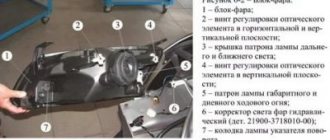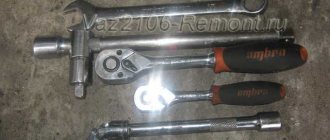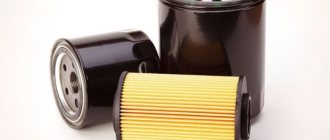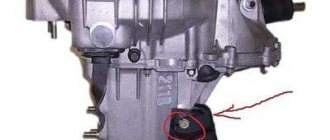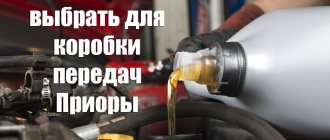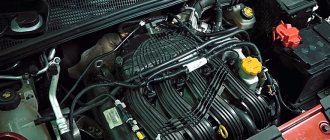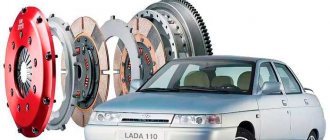From the very beginning of sales, AVTOVAZ has been installing a modified VAZ 2182 automated transmission (AMT with version 2.0) on the updated Lada Granta family. “Robot” received a number of improvements and new operating modes, which had a positive impact on user ratings. The article presents reviews from auto experts and owners of these cars.
Reliability and operating features of the robot box in the Lada Grant
The design of a robotic gearbox is simpler than an automatic one with a torque converter: the cost is lower. Therefore, AMT began to be actively installed on inexpensive car models.
A robotic gearbox is a kind of compromise between a manual and an automatic transmission. The Lada Granta is equipped with a VAZ-2182 manual transmission. AMT (Automated Manual/Mechanical Transmission) is equipped only with cars with a 16-valve engine. How long the robot can walk on the Grant largely depends on its driving style.
Automatic transmission
“Automatic” was installed on the car of the Tolyatti Automobile Plant from July 2012 to March 2021 - this is 4 speed. Automatic transmission from Japanese manufacturer Jatco.
Grant's four-speed automatic transmission - model JF414E, classic type, with a torque converter; similar units are equipped in Nissan, Mitsubishi, and Suzuki passenger cars.
This type of transmission on Granta is paired only with the 98-horsepower VAZ-21126 power unit.
The gearbox is highly reliable; with careful operation and timely maintenance, it can run up to 200 thousand km.
It is necessary to replace the transmission fluid every 60 thousand km; the manufacturer recommends filling with Nissan branded ATF EJ-1 or Matic-S oil.
The quality of the Lada Granta automatic transmission does not cause any major complaints; if the transmission requires repair, it is mainly due to the fault of the driver:
- as a result of slipping, the clutches burn out;
- after overheating, gaskets and seals begin to leak;
- When you hit an obstacle, the automatic transmission pan breaks through, and then a thorough repair is definitely required.
Vesta "robot" - AMT
AMT for Lada Vesta was initially created only for the Lada Priora car. The fact is that the design of this model did not allow the use of full-fledged automatic transmissions, and the plans were to produce this car for a long time. To develop the “robot,” we took an ordinary mechanical box as a base and added a computer and drives from the German company ZF. The unit turned out to be so successful that it subsequently appeared on Grants and Kalinas, completely replacing automatic transmissions.
The AMT box has also reached the Lada Vesta. Successful operating experience of this unit made it possible to use it on more modern cars without any modifications. Among the technical features of the “robot”, it is worth noting the low weight - only 5 kg heavier than the “mechanics”, low cost - 20,000 rubles, versus 40,000 rubles for the JATCO “automatic”, as well as the simplicity of the design - a well-known gearbox and several controls.
Disadvantages of the "robot":
- When parking uphill, the car rolls back, so you need to fix the position with the gas pedal or hand brake.
Advantages of the “robot”:
- Protection against incorrect gear engagement;
- Two switching options are possible, fully automatic and manual;
- Possibility of sharp acceleration as on mechanics;
- One or two gear reset mode;
- Average fuel consumption is 6.5 liters per 100 km in urban modes and 5.1 liters per 100 km on the highway;
- The required oil volume is 2-3 liters, for automatic transmissions and CVTs from 7 to 10 liters;
- You can start driving immediately after starting the engine, including in severe frosts;
- Automatic adjustment of the transmission mode to the driving style of a particular driver;
- There are no vibrations in the gearshift lever;
- Ability to tow trailers or other vehicles;
- Quick gear changes, no jerking.
Features of the robotic gearbox:
The clutch closes very smoothly, even if you press the gas sharply; If necessary, you can manually reset one or two gears for quick acceleration; There is protection against engaging reverse gear when moving forward; There is a howl in certain gears, but it is several times less than in the “mechanics” from AVTOVAZ; The service life of the AMT is 10 years.
Praise and nothing more
Despite all the above shortcomings, the car is gaining a lot of positive reviews. Due to the fact that the AvtoVAZ company considers this project to be the most successful, which combines all the positive characteristics of previous cars. Proof of these words are many videos posted on the Internet with admiration and pride in the form of special custom tuning.
The car collected many positive reviews in 2013-2014. During these periods there was a peak in car sales; they were constantly bought for taxis. This means that drivers consciously went to purchase the highest quality car, the resources of which will be used for wear and tear. After all, a taxi is “on wheels” for almost 24 hours and constantly on different routes.
Car owners often call Grant an all-terrain vehicle because it “feels” exactly the same:
- on city roads;
- on country roads;
- in field;
- In the woods;
- fishing;
- on the hunt.
Each car owner covers the first 30,000 kilometers in a different time, some in 3 years, and others in a year and a half. This mileage is already a symbolic indicator of the quality of the car.
The description of its advantages from drivers over the subsequent 2015-2017 years simply does not fit on one page:
- quick completion of scheduled technical inspection due to the absence of serious malfunctions;
- excellent heating system;
- spacious interior;
- high ground clearance (allows you to overcome snowdrifts);
- relatively low fuel consumption (compared to similar analogues);
- good value for money.
Many car owners, and we are no exception, agree that the Granta is the most economical car, from cost to fuel consumption and repair costs.
And knowing the desire of many residents of Moscow and the Moscow region, as well as guests of our big city, to try themselves as drivers of domestic models - including the Lada Granta - we simply could not help but replenish our fleet with these cars.
If you are thinking about purchasing a new VAZ classic or just want to “drive” without extra costs, then perhaps a daily rental at very competitive prices from our company is exactly what you need to get to know this car better than on any test drive !
Contact Information
Moscow, Pyatnitskoye sh., 24
Tel/fax
You can also contact us via the feedback form
Helpful information
- Car rental
- Car rental from the airport
- Sample car rental agreement
- Car under repair
- WI FI in the car for free
- 24-hour car rental in Moscow
- Car sharing car rental in Moscow
- Car rental for a day: why is it more profitable?
- Three approaches to choosing the best car for the city
- Features of driving in the rain
- Secrets and techniques of parking a car
- Isn’t it possible to get to the Baltic states by car from Moscow?
- How to prepare a car for winter?
- Do you need a driver when traveling when renting a car?
- Features of driving a car in winter
- Driving a car with a manual transmission: how to drive
- Lada Granta automatic – auto magic or.
- Methods for attaching child car seats
- How to deal with skidding
- How to avoid falling asleep while driving?
- Car rental for traveling around Russia
- Questions and answers
© , 2003–2021 — Car rental in Moscow Tel. Email Address: 123310, Moscow, Pyatnitskoye sh., 24с1 IP Avtamonov S. A. INN 772205040185, OGRN 304770000594313
rent hyundai solaris rent Polo Volkswagen rent lada largus
vote
Article rating
Advantages and disadvantages of AMT
“Robot” is installed on a wider range of Lada cars (Granta, Kalina, Priora, Vesta and XRAY) and has a number of operating features. According to AvtoVAZ, the robotic gearbox is distinguished by its simplicity, reliability and efficiency. In addition, the robot is easy to maintain, and its repair cost is practically no different from repairing a manual transmission. Fuel consumption corresponds to that of a manual transmission.
The disadvantages of this transmission are mentioned in reviews of owners of Lada Priora with AMT. An “automatic” changes gears with almost no loss of traction torque, but a “robot” cannot do this. It is this moment that car enthusiasts do not like. In addition, there are discussions about the hum and howl of the AMT.
Both transmissions make driving easier, which significantly reduces driver fatigue, especially in traffic jams. What transmission do you recommend for Lada cars? Let us remember that cable “mechanics” are famous for their howling.
AVTOVAZ presented an updated robotic gearbox. “Behind the wheel” found out what had been changed, and tried out robot 2.0 in action on serpentine roads and in traffic jams in the city of Sochi.
LADA > XRAY
LADA > Vesta
The Lada Brand Day event was held in Sochi, where the VAZ team presented an updated robotic transmission. This is what AMT project manager Vladimir Petunin told ZR:
“The automated gearbox was created jointly with partners from Germany: the main one is ZF, the co-partner is Porsche Engineering.
Porsche specialists were tuning the basic version of the transmission. Over the past four years, we have watched AMT advance in the market. We were interested, first of all, in complaints from users. To date, we have made a number of improvements that are associated with changes to the transmission control program.”
No fundamental changes to the actuators were required. However, there are still innovations in the hardware - the control controller now has not one, but two boards, and, of course, a different transmission control program. So owners of robotic cars will not be able to simply come to the dealer and reflash the box.
What did they change?
The “traffic” mode, or, as it is officially called, the Creeping mode function, which appeared this year, has been retained. The driver simply takes his foot off the brake pedal and the car begins to roll forward. The speed in first gear is 7–8 km/h, in second gear it is 14–15 km/h. When you engage reverse, this mode also works - the car crawls at a speed of 5–6 km/h.
In this case, the Creeping mode function is turned off automatically under one of three conditions: if you open the driver's door while driving, if you move the selector to neutral or tighten the parking brake handle. That is, suddenly the car won’t move on its own.
It is now possible to start in second gear, in manual AMT control mode. This is the so-called “winter” mode of operation of the gearbox. VAZ drivers promise that this will make it easier to start on a slippery road.
A sport mode (not to be confused with Kick Down) will also appear soon, which can be activated with a separate key on the panel. “Sport” will operate in modes A and M (automatic and manual, respectively). In this case, the electronics use other engine and transmission settings.
In manual mode, at maximum engine speed, there will be no forced upshift.
Recommendations
Comments 22
the robot itself is unreliable but the most economical of all types of boxes! but I would never take such a miracle of the Russian automobile industry)))
If there was a sport on a robot, then you can
I would take it with a machine gun, but never with a robot)
Now it’s too early to judge the robot, I would probably take it... because... The third pedal is already boring... the reviews are mostly positive, but what will happen to the gear selection and clutch drives after 50,000 km is unknown, my sister had a Ford robot, the gear selection mechanism broke down, and we couldn’t get it repaired anywhere in Perm, we had to buy a gearbox from collection in Eburg for 55,000 rubles. the faulty one was sold for 15,000... in total, the repair cost 40,000 rubles. Moreover, they changed the box on their own, naturally the car was immediately sold...
here you are right! Although when I took mine with automatic transmission, there was no information either, because as soon as they went! Well, no problem, I've driven almost 50,000 km, no problems)))
I’ll tell you this: I drive a Grant with an automatic transmission... yes, 5th gear is missing on the highway, and the consumption is 1.5 l/100 km more than with a manual transmission, but I don’t want to change 2 pedals to 3! It's just a thrill to drive without worrying, especially in traffic jams! At work, an employee drives a Priora with a robot... So, its consumption is only 0.5-0.7 l/100 km more than with a manual transmission. The car is new, no problems. And what kind of problems there might be? if it’s essentially the same manual transmission, where instead of a clutch they’ve installed brains that decide for themselves how to control it and when to shift gears))) I still can’t get it for a test drive ((((I wonder how it’s different; it’s an automatic transmission
The 4th gear ratio on an automatic transmission is 0.697 (the main gear is 4.081), and the 5th gear ratio on a manual transmission is 0.784 (the main gear is 3.7). At 3000 rpm, the speed will be as follows: automatic transmission - 116 km/h, manual transmission - 111 km/h The fourth automatic transmission even wins over the manual transmission)) www.kartuning.ru/gearbox-calculator
I don’t argue, but the consumption starts to rise like crazy when you go beyond 110! I think it would be a 5 speed automatic transmission. This wouldn’t happen) And so I’m happy with the automatic machine)
If our automatic transmission was 5 speed, then there would be no price for it)). I noticed that consumption begins to increase when overtaking, when the hydraulic injector opens and begins to slip.
yes yes) overtaking and x.x the consumption is too high, about 1.1-1.3 liters shows the State ((((
The 4th gear ratio on an automatic transmission is 0.697 (the main gear is 4.081), and the 5th gear ratio on a manual transmission is 0.784 (the main gear is 3.7). At 3000 rpm, the speed will be as follows: automatic transmission - 116 km/h, manual transmission - 111 km/h The fourth automatic transmission even wins over the manual transmission)) www.kartuning.ru/gearbox-calculator
Just one question...)) Why drive 4 at such a speed when there is a fifth))) In the city I stick the fifth on the Grant handle after 60, and the robot is in economy mode too
Technical shortcomings - how else can you criticize Robot 2.0?
A small database of reviews about the second generation of the robotic box has already been collected. The first clutches have already fallen off, so be careful with this creeping mode. But that's not the worst thing. You just need to get used to the behavior of the box and understand how it should be operated without putting unnecessary stress on the main parts. Otherwise, there are still a lot of shortcomings that will apparently be eliminated in robot 3.0. I wonder if AvtoVAZ specifically left these shortcomings so that there would be something to work on further?
There are several general disadvantages of the new gearbox:
- the kick between first and second gears remains, before it was a failure, but now it’s a kick, but the discomfort from this change has not become less, there is a desire to drop the gas pedal;
- the reverse gear is engaged inadequately, the car is already rolling, and at this time the driver feels a noticeable blow, as if on an old Japanese automatic machine that requires major repairs;
- the creep mode in first gear is very aggressive, and this not only constantly affects the clutch, but also wears out your pads, since you have to constantly brake;
- the design of the unit may not be the best, since the assembly is Russian, so precise mechanisms and parts of foreign design may not take root in a domestic device;
- it is not entirely clear whether the device will withstand the loads placed on it; it seems that Vesta is too heavy and large for this gearbox, and this feeling is only getting stronger.
Impressive result of good work
As a result, we can come to the conclusion that the VAZ team managed to create a good “robot”. What is especially impressive is that the project initially included unification, allowing the design to be quickly adapted to a number of models. The new AvtoVAZ product is in no way inferior to its analogues. From what is known, no unit with a “robot” has such elastic and smooth operation of the power unit.
Therefore, the “traditional” Jatco “automatic” has been replaced by a new product. This happened because VAZ’s “robot” is really quite good and is capable of satisfying the needs of the most demanding drivers. But the partnership with the Japanese continues, because it is necessary to give potential buyers maximum choice.
Today, cars equipped with automatic transmission and automatic transmission practically do not differ in price. But a price increase is coming for currently inexpensive Japanese-made automatic machines. After all, automatic transmissions are imported from Japan complete with a cooling system and require Japanese wheel drives. For AMT, everything was developed at AvtoVAZ. The only exceptions are actuators, control unit and selectors. The difference in price between a manual transmission and a “robot” is only 20,000 rubles. Jatco, even without taking into account drives and cooling, costs more than twice as much as a “robot”.
Features of the “behavior” of the robot after running in
As a rule, after running-in, the robot and the driver adapt to each other. The driver already automatically starts the engine from the neutral position of the lever and simultaneously presses the brakes. Gear changes have returned to normal and become shifts without interruption in the power flow or without “jerking”.
Some reviews regarding the “behavior” of the robot after running-in recommend not to “fall” on the gas pedal when starting to move, trying to quickly gain speed to switch from the initial speed to the next one. This manipulation does not give the desired effect, however, the transition from second gear to third and subsequent transitions will be carried out much faster, unless, of course, you reduce engine speed by releasing the gas pedal.
In traffic, it is recommended to accelerate within the appropriate gear for the traffic flow, which makes driving as economical as possible. In this case, the gas pedal can be used to control the robot, indicating the engine speed at which switches it needs to make.
Disadvantages of AMT
It is known that there is not a single unit or structure in nature that is free of shortcomings. There are also disadvantages to such a popular and sought-after AMT:
- You can’t get used to reprogramming: we put the comma ourselves.
If the driver intends to change the dynamics of the car or save the car's resources by reprogramming the AMT, he will be disappointed. It is impossible to reprogram this type of gearbox.
There is only one way out: without trying to adjust the AMT to your driving style, adapt yourself to some of the features of its functioning.
However, a reservation should be made here. After the car's warranty period expires, our craftsmen still manage to reflash the AMT electronic control unit. It cannot be said that this procedure is guaranteed to lead to improvements in car dynamics, but such attempts are made regularly by domestic car enthusiasts.
Low switching speed.
Those who are used to driving with an automatic transmission often complain that the AMT is too “slow.” This drawback is the result of software costs and is inherent in any automatic transmission. Unfortunately, here you have to choose between the presence of an “automatic” and the speed of switching; The modern auto industry, alas, has not yet come up with a third option.
Availability of manual mode.
When driving in traffic jams or on rough terrain, switching to manual mode for AMT is mandatory. Otherwise, the AMT will very quickly exhaust its service life and become unusable.
This minus can only be called a minus conditionally: some drivers, on the contrary, warmly welcome the ability to manually change gear in AMT.
Jerks when switching.
Sometimes, when changing gears, jerking is felt when the car is moving. The reason is that the gas was not released at the time of switching. This is not exactly a drawback, but rather a feature of AMT operation: it is important to learn how to not fully press the gas pedal in this situation.
- Poor performance on steep climbs.
When driving up a steep hill in vehicles equipped with AMT, the clutch may disengage. This happens when it overheats. It is for this reason that a robotic gearbox has the option of manual shifting. Again, this is not a flaw, but a design feature.
Frequent defects
The defects listed below are most often found on VAZ 2107 cars
It is important to diagnose the problem in time and try to repair it.
Increased noise
Increased noise or howling of the gearbox is caused by bearings and synchronizers that are suitable for replacement. To find out whether a bearing needs to be changed, just look at it visually and twist it. The teeth of synchronizers often lick off, which results in gear shifting with a crunch.
Difficult gear shifting
After making sure that the clutch is in working condition, you need to look for the following reasons:
- the gearshift lever hinge is clogged (can be treated with regular cleaning);
- the gear shift fork is deformed (if the deformation is minor, it can be straightened);
- The sliding clutch and the shift fork rod are tight.
Knocks out gears
After completely disassembling the gearbox, it will be clearly clear why the gears were knocked out.
Finding the reasons for the transmission being knocked out.
There may be three reasons:
- wear of the blocking ring, coupling and synchronizer ring gear;
- loss of elasticity of the retainer spring;
- synchronizer spring failure.
In these cases, only complete replacement of parts helps.
Oil leak
Again, 3 reasons for this defect to appear:
- seals leak;
- the tightening of the cover bolts has become loose;
- gasket is damaged.
AMT gearbox - what is it?
AMT - Automated Manual Transmission - automated manual transmission. Car enthusiasts call such a box robotic or, simply, a robot.
This is a reliable manual transmission, known since the very beginning of the automotive industry, but with automatic shifting. Simply put, if you are asked, “AMT gearbox, what is it?”, boldly answer: “It is a mixture of manual and automatic.”
That is, the gearbox is mechanical, but the computer depresses the clutch and changes gears based on its calculations.
It takes data from various car systems, analyzes speed, ABS readings, etc., and then, using force transmitting devices - actuators or also called servos, switches gears.
In AMT boxes, actuators are either electric or hydraulic.
Such boxes are installed on budget cars. And it is they who cause dissatisfaction among motorists and a skeptical attitude towards AMT.
The fact is that when accelerating a car, you may feel “freezes” when changing gears and even a decrease in speed at the most inopportune moment (for example, when changing lanes or overtaking).
There may be no traction between the engine and the wheels for up to two seconds, which impairs the car’s handling and irritates those who like to drive fast and harshly.
However, this is a good option for those who like a smooth and measured movement.
- A hydraulic robot (also called electrohydraulic) is more expensive and is installed on premium-segment cars and sports models.
The hydraulic one uses a cylinder that is pushed by solenoid valves.
A special liquid is poured into such a box, which allows you to reduce the thought time to 0.05 seconds.
- Since 2003, the Audi and Valkswagen concerns began installing dual-clutch robots on their production cars.
The technology itself was invented back in the 80s of the last century. The box has two shafts at once: one for even gears, the second for odd ones.
The next gear on the adjacent shaft is engaged in advance, but it is open until the required moment. When the electronics decide it is time to switch, one shaft is simultaneously disconnected and the other is connected.
This gear shift is called preselective. Thanks to him, the car gets a very smooth ride, the driver does not notice the switching.
For example, on a Volkswagen Golf it occurs in just 8 milliseconds. If you see the abbreviation DCT (Dual Clatch Transmission), then it is a dual-clutch robot.
Also, in common parlance, it can be designated by the abbreviation DSG, after the name of the box of the Volkswagen concern, but be manufactured by another company (by analogy, the words copier, diaper, etc. appeared in the Russian language)
AMT gearbox
When it comes to the pros and cons of AMT, it’s worth immediately remembering what is an AMT gearbox?
This is a combination of the reliability and low cost of a manual transmission with the convenience of an automatic transmission.
From this we can understand that it combines the pros and cons of both types of transmissions.
pros:
- There is no need to depress the clutch and move the gearshift lever, the computer will do it. Particularly relevant in urban traffic jams.
- Cheaper than an automatic transmission, but there are still two pedals. This gives the convenience of an automatic at a price approaching that of a manual.
- It is more reliable and easier to repair than an automatic transmission, because the gearbox is, in fact, mechanical.
- On many models, you can change gears manually if necessary.
- Fuel consumption is lower than that of cars with automatic transmission and manual transmission. In an automatic transmission, the operating principle itself implies higher consumption, and in a manual transmission, the driver plays a role with his driving style and untimely switching.
- The AMT gearbox weighs less than an automatic transmission. It is suitable for small cars.
- The service life of a dual-clutch robot is longer than that of a manual transmission.
- Less oil required in the box.
Main problems of DSG7 - video
Lada granta ground clearance
Weak points of mechatronics
DSG 7 - disadvantages
There are car enthusiasts who are not 100% satisfied with the performance of this transmission. What could they not like and what problems arise in the DSG box?
Is the DSG7 gearbox that good?
– The appearance of jerks and vibrations in the DSG when changing gears. This drawback is caused by the fact that the DSG clutch begins to wear out. The result is the same effect if you do not depress the clutch pedal when changing gear in a car with a manual transmission. In a word, the vibration spreads throughout the entire body, depending on the state of the clutch, and progresses until the gearbox completely fails.
– Extraneous noises under the hood. Mainly metal parts when driving over speed bumps.
– Reduced traction when accelerating the car. This problem is known to the developers and they promise to fix it soon.
Test drive Lada Granta Cross on a “robot”: tests on the M5 highway and village dirt
Sometimes it is difficult to take on the role of a lawyer because you know in advance that the case will be lost. But it’s either passion, or duty and a matter of honor - and you take it on. It's boring at first: all the scripts are known in advance and differ only in details, like good remakes. But as you dive in, something clicks inside, and the “bartender” you’ve known since birth slips you a strange cocktail of sympathy, empathy and hope... And with this Lada Granta Cross it couldn’t be otherwise.
What does it look like
Everyone has already been able to get an idea of the appearance of Granta Cross. This is the same Kalina Cross, which, after restyling in the summer of 2018, had to unite with the Grants family, forming a powerful clan with the best sales results that have been maintained for many months. If you want a quick summary, the Lada Granta Cross looks great.
What is inside
The interior is expectedly cramped after the same Rio, Solaris and Vesta. It’s only when you sit in the Grant that you feel it somehow especially acutely. Perhaps because you expect a little more from this car. And I have an explanation for this: when Lada didn’t have Vesta, Grant was listed as a competitor to the “Koreans” and Renault Logan. Apparently, the expectation effect works on a subconscious level.
The upholstery is made to match the body color. And the gray one doesn’t look as intrusive as the flashy orange one
The seats are surprisingly comfortable, the cushion under the thigh is just right, the steering wheel is height-adjustable, there is a winter package that includes heated windshield, front seats, exterior mirrors, which, by the way, are adjusted electrically, and there are only two pedals , because an automated manual transmission (AMT) works in tandem with a 106-horsepower VAZ engine. Let us remind you that Lada engineers are protesting against the nickname “robot”.
How Granta Cross rides on a “robot”
When getting behind the wheel of a car - any car that is taken for a test - you should push away any skepticism and baggage of stereotypes. But... it's Lada! The point is not that there is a thesaurus that has developed over years of work - no, in this case everything is more complicated, it is somewhere on the mental level. Therefore, it is difficult to believe that Lada cars can be normal. If Volkswagen’s “robot” breaks down, then what about ours? Moreover, in a video on YouTube some “Andrey Avtomaniac” stated that “the algorithm is stupid”...
But here's what I think: it's impossible to understand a car by renting it for just three hours. You need to become close to him, grow together and then draw some conclusions. Fortunately, the Lada Granta Cross was given to me for a few days, just before the trip from Tolyatti to Bashkortostan planned for the weekend. Before a long trip in the evening I tried it out around the city. More precisely, I refreshed my memories: I managed to test the car back in the summer of 2019 in Adygea, together with VAZ engineers and PR people. And this is a thrill: a car with two pedals in even small traffic jams. It starts smoothly, the main thing is not to press too hard on the gas, and then it will go smoothly and comfortably. If, as usual, you press the gas sharply and all the way, for example, when entering a ring, then the AMT may simply not understand what they want from it and which operating algorithm will be the best.
On the AMT track, the Lada Granta Cross performed well. Sometimes, however, the car reminded me of my grandfather, who, after the IZH Combi, bought himself a “four”. The Kombi has four gears, while the VAZ station wagon has five. But my grandfather stubbornly ignored fifth gear; the engine really roared when the speed approached 100 km/h. Well, whatever you want, force of habit: almost 20 years behind the wheel of IZH.
AMT did not always understand me, and I did not always understand her, and the result was not a ride, but some kind of argument with a stubborn teenager: you know what’s best, but he is sure that the truth is on his side. For example, you are moving in a straight line at a speed of 95-100 km/h, and the on-board computer display indicates 4th gear. (Grandpa, hello!) I can’t say that this caused any particular discomfort, but the vibroacoustics definitely suffered. Only, as it turned out, the “robot” is not to blame for everything.
After three hundred kilometers driving the Lada Granta Cross in this mode, I suddenly remembered my father’s words: “The car doesn’t like sudden movements, everything needs to be done smoothly.” And at that moment, already habitually flying at fourth “cruising” speed, I slightly released the gas pedal... The gearbox engaged fifth. Miracles!
The Lada Granta Cross is equipped with a “robot” version 2.0, which, in addition to clear operation algorithms and smoother switching, is distinguished by the presence of a Sport mode. The activation and deactivation key is located on the center console and can be operated while driving. The owner's manual says that Sport mode is designed for dynamic driving and more intense fuel combustion. There really is a difference in dynamics: the engine picks up speed faster, and the AMT shifts gears later. Actually, there is no need to explain here why VAZ employees warn about increased fuel consumption. During the entire trip, I dabbled in “Sport” only a few times and gave it up.
Granta 1.6 16v AMT (robot)
I wish you all good health! Reading reviews is of course pleasant and useful, now you also need to make your contribution, so don’t judge harshly, especially for mistakes (I was in a hurry, and I want to write more + no, the beech is stiff and the buttons are small).
Lada Granta (luxury equipment)
ICE: 1.6; 16th grade; 106 l/s, gearbox: 5st. robotic.
Equipment: ABS; 2PB; 4ESP; Climate; Heated front seats; Rain sensor; Two rear parking sensors; Fogs; Wheels R15; Radio with touch control; Standard alarm.
Over 11 years of driving experience, I personally owned: the first was my grandfather’s Moskvich 412 (whatever this car couldn’t stand from me), then the VAZ 2105 1.3 85 onwards. on gas (after Moskvich, a comfortable and stable car), VAZ 2106 2006. (drove for about 2 years), then an almost new 2105 (injection 5-speed, also drove for about 2 years), Toyota Platz 2001. (I got the car in excellent condition, drove it for 3 years, didn’t know any problems, but I wanted more and lost it), Nissan Cefiro 1998. 2.5 210 hp Neo-Di engine which does not run on gasoline below 95, the car is cool but already old and it eats gasoline normally + expensive insurance, taxes (drove for 2 months and sold it), Honda Civic 2000. 1.5 (8 valve automatic - I was shocked myself) right-handed sedan made for the Emirates, no ABS, no airbags, terrible heater. but there is a leather interior and climate control (the car was received in poor technical condition. I thought I’d do it little by little, but it didn’t work out due to financial difficulties, I thought it was about to break down BUT! the car was almost unchanged in technical parts, traveled 3 -and years... low bow to her, the car is really very reliable and durable, although it is designed for good roads and active driving, so the chassis is quite harsh). All cars are worthy of special attention, but we are not talking about them now. And now. TA-DAM! New Lada Granta))

